Risks in Public with People
December 4, 2022
Text by Gilian Rappaport with Constance Hockaday
“Some people make art with paintings and some people make art with sculptures and some people make music and I like to make things happen. I like to take risks in public with people. I like to make magical things happen – unexpected happenings.”
Constance Hockaday
On September 18th 2022, Ralph Hopkins, Halo Kaya Perez Gallardo, and I collaboratively created the public art project known as Ralph’s Neon Oasis Beach Party on Riis Beach, the gay beach in New York City. We envisioned a historic re-enactment for the project based on the participatory public fashion shows that Ralph created in the nineties in the same location (see “SOFA Journal: They Call Me The Mayor at Riis Beach,” Fall 2021), with an emphasis on providing beach goers with spontaneous opportunities to walk the mylar runway on the sand in clothes made by local fashion designers and to bask in community joy. As the event took shape, I realized that it wasn’t a re-enactment so much as it was a re-creation: we functioned as more than a group of viewers of a “past performance.” We were a community of queer artists shaping the physical and social world around us, and in turn, the ideas, behaviors, and meaning of the environment surrounding us. Through the process, the hundreds of people who participated that day established a force of magic at a crucial moment on this historic patch of beach where gay people have come together to be free together publicly since the 1940s, and a place that is threatened due to an upcoming city-initiated demolition project (see: NYTimes, Reuters). Maybe we became our own kind of arts commission within the city, even just for that moment. Through this work, I am interested in breaking down the distinction between the centered and the marginalized to focus on what it really means to be a beacon of community.
In 2011, Constance Hockaday created an interactive installation in the form of a hotel on the Rockaway Peninsula in Jamaica Bay not five miles from Riis Beach, where they worked with storytellers, nautical enthusiasts, and city planners to host overnight visits, performances, and movie screenings about the water and water identities. The intensity of the pavement/ocean divide in Rockaway emphasizes the relationship between urbanness and nature. Constance’s installation, called Boatel, created a queer infrastructure on the open waters surrounded by laws of the land, like gentrification and displacement, sexist, ableist, racist, and classist policies, the tragedy of the commons, false public space, outrageous rent costs, lack of resources, media censorship, and all the other structures upholding the state of the ongoing housing crisis. Constance’s art practice is a tool for understanding how and in what ways the land does or does not support the development of thriving non-capitalistic and sex positive, queer culture and art spaces.
In Alexis Pauline Gumbs’ book Undrowned: Black Feminist Lessons from Marine Animals, she asks, “What do we need to remember that will push back against the forgetting encouraged by consumer culture and linear time? What can we remember that will surround us in oceans of history and potential? And how?”. She traces the ecologies of marine animals by observing their migratory patterns, echolocation, and other elements of their submerged wisdom, looking to nature for cues around how we can re-create paths for wild and ordinary magic in our communities. This work helps manifest a shared belief that communities can come together to create worlds where we belong.
In this piece, Constance and I discuss specific works from their practice that call attention to the relationship between nature, art, queerness, and living in the age of climate catastrophe. I think this set of works function together to hint at some of the richness behind why I decided to initiate Green Flash Projects— a quest to come together with queer artists creating spaces for belonging in nature. These works inspire me to think more deeply about how sites for art in nature can function as spaces where we can wake up to our innate power, imbue natural sites with collective meaning, and ultimately encourage stewardship of the land.
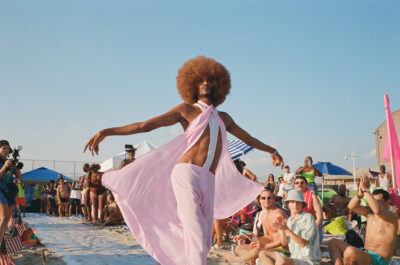
Ralph’s Neon Oasis Beach Party. Co-organized by Ralph Hopkins, Halo Kaya Perez-Gallardo, and Gilian Rappaport. Sep 18, 2022. Social Sculpture on Riis Beach in Queens, NY. Photo by Christian DeFonte.Gilian Rappaport: How do you explain social practice to non-artists?
Constance Hockaday: I don’t like the term social practice. I prefer social sculpture. When I make work, the audience is almost always a part of the work and social sculpture makes that more explicit.
Some people make art with paintings and some people make art with sculptures and some people make music and I like to make things happen. I like to take risks in public with people. I like to make magical things happen— unexpected happenings.
If I’m inviting a bunch of people to a floating peep show in the middle of the San Francisco Bay (see ‘All These Darlings,’ a Floating San Francisco Peep Show), the audience is just as much a part of the spectacle as anything else because they’re all having to take their shoes off and get on this boat. And there are sailors and sex workers. And they’re all in a little boat together. And they’re being taken out into the middle of the water. It’s about getting the audience to take the risk with you, and that implication.
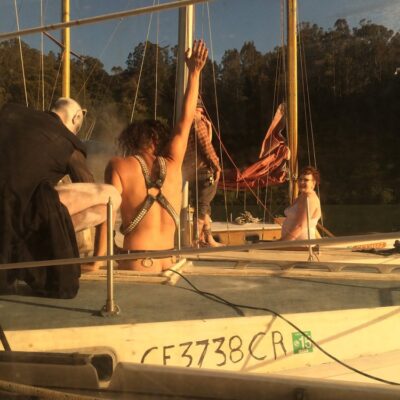
ALL THESE DARLINGS AND NOW US. Constance Hockaday. 2014. Interactive/performative installation in the San Francisco Bay, CA. Photo by Constance Hockaday.Gilian: I resonate with what you’re saying about risk taking.
Since I am a resident of the Rockaway Peninsula in NYC, I’m especially curious about The Boatel project. Was that a big part of your motivation for that project at that time, the magic of taking a risk with the public?
Constance: There are not a lot of venues where something can happen that we didn’t plan for: that type of adventure, surprise, or possibility. Capitalistic, socially constructed, well-worn paths of predictability don’t really make me feel very alive.
I’m asking, Can we create infrastructures for moments of suspension? For expanding our ideas about what is possible?
In Santa Cruz, California, there are staircases that go straight into the most raging Pacific Ocean waves. People walk down those stairs and get in the water with their children. That infrastructure is telling those people your body belongs in this place. In other places, there isn’t that infrastructure signaling that your body is allowed, belongs, or can explore this place.
The Boatel was about creating access and infrastructure into a world of this is also possible. A temporary space telling my body that I can belong and interact with people in a different type of way. That is what the waterworks are almost always about.
The Peep Show was also asking, If the rules of the land do not allow for my desires, then can we move into another space where the rules at least temporarily do allow for that thing to happen? Private property and its rent raises and gentrification do not mesh with thriving non-capitalistic queer culture and sex positive, queer art spaces. The water allows you to own the space that you’re occupying in that moment in a way that land does not.
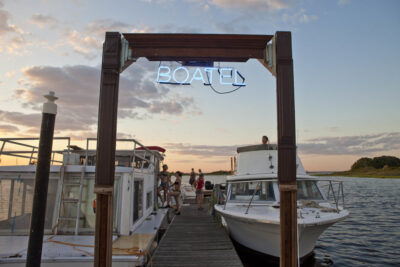
The Boatel. Constance Hockaday. Interactive/performative installation. 2011. Jamaica Bay, Queens, NY. Photo by Todd Seelie.Gilian: Are these projects always designed to be temporary? Having spent some time living on a houseboat in Marina 59 where The Boatel took place, I know a little bit about the huge amount of maintenance that goes into those projects and making them feel inhabitable.
Constance: Most of my ideas want to exist at scale and are difficult to execute. There are very few supporting arts institutions that will support this kind of work. So, to make work at scale with support, it’s like you have to win the lottery. I have gotten almost to the finish line with large museum-type institutions working on some massive project, and then they pull the plug for liability reasons. The water really scares people.
I have project ideas that are more like permanent infrastructure that would exist along the LA River or in a decommissioned ship in a port city somewhere. I’d love to make something durational and semi-permanent— self sustaining, even, just to get out of the begging for money cycle that all us artists are in. Most of what I have created has always involved creating a small business around the work so that the work can support itself. The Boatel was able to support itself, and The Peep Show too.
But this kind of social sculpture is a herculean effort— especially when you are trying to create it on your own, and only for a short moment in time. People asked me to keep doing The Boatel, and I was like, I’m not a hotel mogul. Now it’s been almost 12 years, so things are different and I actually think I could sit with a really durational piece about infrastructure for togetherness or infrastructure for communion with a certain type of watery space. I’m not looking for temporality, it’s just an ingredient that makes it possible for me.
And on the other side of my thinking, I try to remember that just because it’s temporary doesn’t mean that it doesn’t have value to my community. Because once you have that experience of opening a hotel in New York City and no one telling you that you can’t do it, even if it was temporary, you have that in your body now. Now you know and I know that we actually can do it. Next time you feel like doing something like that, you will try.
Gilian: I’m curious about your musings on temporality.
Constance: I think about the water as fast land. When you’re on the water, the land is moving faster so in order to engage with the space, you are required to go through a physical process of habituating the movement. I think that is an important exercise— being able to make clear and top of mind the fact that the world, the land, all of it is changing and moving all of the time.
In the book Water and Dreams, Gaston Bachelard talks about love of the water as a participatory type of love. With something like water, which is in constant motion, you have to participate in order to continue loving it. In order to love the water, you have to love the shape that water makes in one moment, and at the same time, love the fact that in the next moment that shape is now dead, and that the next shape will come. In that sense, you can understand that temporality is a state of being.
I can’t get too excited about it in this certain housing climate though because I believe that people deserve to have a sense of place and deserve to marry themselves semi-permanently to a piece of land that is always changing. I think that we as a species need that, and the world is making that very difficult right now. We all need a place to live and belong to, no matter how much it’s changing around us. For now though, if we can sustain the water’s rocking, we are able to hold on to a space there.
Gilian: How do you see your work existing in the midst of our climate catastrophe?
Constance: I think about disasters and the future a lot, and the problems that we have with scale. Climate change is a problem of extreme proportion that we, for the most part, experience on a conceptual level. So it’s a relationship to faith: to believe this thing is happening, and live your life as if this thing is happening on a daily basis even if you can’t always see it.
We have a normalcy bias that we cannot escape. It is the same thing that allows for me to be able to stand on a boat and habituate that movement. Your body says, Okay, this is normal, I’m just going to run this program, of balancing on a moving vessel, so that you can focus on something else. Normalcy bias is an important thing to have but it’s not going to help us face climate change.
I was reading this survivalist memoir guy (Deep Survival by Laurence Gonzales) who shared a case study of an airplane crashing into the ground. There was a split-second moment after the crash where some people were able to escape and they did. But there were also a bunch of people who also just stayed, sitting on the plane with their hair on fire, continuing to drink their tea because their brain couldn’t see that the entire world around them had changed. They couldn’t see that things were not normal and therefore they could not change their behavior. Researchers found that you actually have to practice escaping normalcy bias.
In the world of climate change, everything seems normal and then suddenly, it’s not and then it goes back to being normal again. That’s very confusing for us as people aka animals. And so I see it as a weird exercise in faith, in practicing a break from our normalcy bias and in believing in something so much larger and scarier than what we have to face on a daily basis.
I’m working on a project now called the Disaster Furniture Showroom. I’m creating disaster furniture that responds to people’s fears. If you’re afraid of a pandemic and not having toilet paper, let’s create a side table that’s filled with toilet paper. Putting the comedy and the satire aside, which is a big part of that project, it’s an object that brings something into your intimate space that starts to normalize the fact that a pandemic could happen. There’s also this notion of self-sufficiency: as we head towards disaster, more and more people are less and less self-sufficient, and do not understand how to interact with the world around them or build anything that IKEA didn’t put together for them.
And this stuff is hard to talk about directly. The furniture is a third object that can help us have intimate discussions around what we’re most afraid of in the world. We’re projecting our thoughts/feelings onto a third object so we’re sort of separate from it and more intimate with it. It’s more effective than me looking at you and saying, “What have you done to prepare for this disastrous future?”
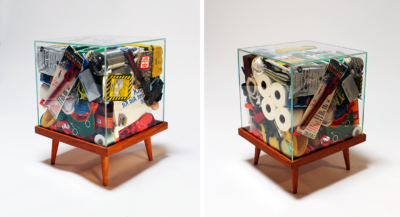
Disaster Furniture Showroom. Constance Hockaday. A store selling real disaster-inspired furniture. Photo by Constance Hockaday.Gilian: Is the furniture for specific people and their specific fears or are they more general?
Constance: As of right now, it’ll probably be both but that could change.
I realized a few years ago that it was time to start leaning into my own thoughts and ideas as opposed to making work that is highlighting someone else’s experience. I don’t think that all social art is extractive, but there is a way that some of that type of project can become extractive. It was time for me to implicate myself in this stuff.
I’ve been asking myself, What do I actually think? What is at stake for me? What am I bringing to this table? Like, I’m not a journalist, so you know, how do I know that I’m not going to Japan and just extracting people’s ideas about disaster in the future. It brings up some questions for me. I’ll say that.
Gilian: Tell me about Old Man, Dance.
Constance: I wanted to create a movement piece with old white men. Because that’s the “worst” thing that you could be right now. I think we’re all walking around with a lot of paradoxes, we are all both good and bad. I was feeling very aware of the moments where I was the dumb white lady, or the dumb white lesbian, or somebody’s major eyeroll. I’m walking around and I’m triggering other people the same way that old white men who stand too close to me in the grocery line, or get in front of me, trigger this whole thing in me.
I decided it was time to embrace this compartmentalization. I selected this category of person that really activates me, and pulled them close. I wanted to try to create an image of old white men trying. I was challenging myself to find a way to use their bodies in a way that was somehow cathartic and healing for people, while also respecting them.
Going back to my comments on extractive social art, at the time I was creating Old Man, Dance I was an artist-in-residence at a women’s college. My first idea was to bring in young women from the college and incorporate their feelings about old white men and translate some of their desires into the movement piece. I had also hired a DEI consultant to help me explore my whiteness and my role as a white woman working with these white men. She pushed me and said, Why are you looking to these young women to tell you what to create? Why don’t you just focus on what’s happening for you and the challenge that you have within your social position to work with these men? It was the first time that I had put myself inside my work in that way. I was always in this producer/director role, bringing together different types of people to make the thing happen, but this time it was me. I was live-directing it and in the middle of it and struggling with all my own shit. And that felt like a really valuable step for me. I think it’s something that we should talk about more in social forms of art. I’m not going to say one thing is better than another but I did feel honest in that piece in a way that I really needed.
Old Man, Dance is not finished. I started it, and COVID happened and I couldn’t rehearse with those guys anymore.
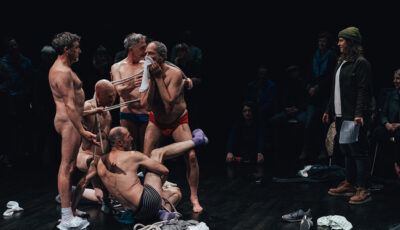
Old Man, Dance (WIP). Constance Hockaday and five white men over the age of 65. Performance. 2019. Mills College, Oakland, CA. Photo by Robbie Sweeny.Gilian: Will you say more about putting your own body and your own experience in the work?
Constance: Yes. Let’s use this Disaster Furniture Showroom example. If I take all these people’s ideas and their fears and translate, recreate, and show them back to you, I am a big part of that. I am a huge factor that is translating the material for the audience, and this complicates the whole notion of ownership. It puts me, the artist, in this position of, You people over here haven’t been considered, or you don’t have the same kind of access to voice, and I somehow will be THE ONE to take this information and give it voice or give it life in a way that you otherwise couldn’t. I don’t like that relationship. I think I need to find more explicit ways to make myself visible. It feels more honest.
To continue using the Disaster Furniture example, I grew up with a survivalist father and he taught me to think about the world in a certain way. For example, I think about what’s going to fall on my head every time I walk into a room because I live in an earthquake state. I have all of this personal baggage and I need to own it.
Old Man, Dance was a convenient way for me to “own” that I’m exploring my inclinations towards white men and their performances of power. And my ability to challenge them in light of being socialized to protect their white masculinity.
If I’m live directing and taking on all of the risk, then the audience is experiencing the risk too. I wanted the way that I’m (me, the artist) taking the risk to be visible.
We have to be accountable for our work especially as socially engaged artists because no one else is going to do it for us. In academia, for example, you have to go through a Human Subjects Panel, a whole board and process of review where colleagues look over your work and make sure that you’re working ethically with people. This type of review has to happen before ever starting working with human subjects. We don’t have that in socially engaged art, there’s just a lot of room for us to be clumsy and miss opportunities to examine ourselves.
Gilian: How do you get to these topics that you value as an artist, for example, making yourself more visible?
Constance: Well in Old Man, Dance, Dia Penning, a DEI consultant who works mainly with white women, challenged me. I would not have gotten there without her. It was hard, and it made me cry. We need people in our community that we cultivate as sounding boards: you don’t know what you don’t know, and you can’t see what you can’t see. Especially when it comes to whiteness and race, we live in a hall of mirrors. It is really difficult to unpack that stuff by yourself. Artists need communities of people.
With the Artists-in-President project, I created an advisory board and I ran every detail around what I was doing, how I was doing it, and how I was engaging people through that advisory board. It’s so much work. It was exhausting, but it made me better.
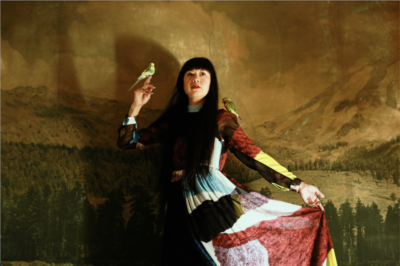
Constance Hockaday [she/he/they] is a queer Chilean-American from the US/Mexico Border. She is a director and visual artist who creates immersive social sculptures on urban waterways that confront issues surrounding public space, political voice, and belonging. In 2001, she began making work with the Floating Neutrinos, a family of psycho-spiritual wanderers who sailed around the world in handmade vessels. She has collaborated with Swoon’s Swimming Cities projects, sailing floating sculptures along the Hudson River, Mississippi River, and the Adriatic Sea (2006-09). In 2011, she created the Boatel, a floating art hotel in NYC’s Far Rockaways made of refurbished salvaged boats— an effort to reconnect New Yorkers to their waterfront. The project attracted 5000+ visitors, international press and critical acclaim. The New York Times described her 2014 piece All These Darlings and Now Us as a “powerful commentary on the forces of technification and gentrification roiling San Francisco.” Hockaday holds an MFA in Social Practice and MA in Conflict Resolution. Her work has been supported by Map Fund, YBCA, Mills College Art Museum, Parrish Art Museum, The Untitled Art Fair, and Flux Factory. In 2016, she was a San Francisco MOMA SECA award finalist. She has been in residence at Headlands Center of the Arts (2016-17), Robert Rauschenberg Residency (2018) and UCLA Center for the Art of Performance. She is a Senior TED Fellow and works as an Organizational Development and Change Management Consultant.
Gilian Rappaport [they/she] is a transdisciplinary artist, writer, and naturalist based in Rockaway Beach, Queens and Portland, Oregon. They were born and raised in New York between the Hudson and Delaware Rivers. They seek to create a sense of belonging in the midst of climate catastrophe. They are also known for their design and research work, supporting the vision for regenerative projects that are renewing and nurturing our world. For updates on upcoming projects, sign up for their newsletter and follow @gilnotjill.


